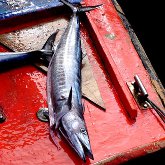Fish Recipes: Our Simplest Salmon Croquettes
May 28, 2012Fishing Tips: Stress-Free Fishing with Kids
June 11, 2012Have you ever accidentally caught a grey nurse shark? Maybe not! It used to be quite common for anglers to reel in the occasional grey nurse shark, but now tagging and tracking efforts have shown that nurse shark numbers are declining. For anyone who has never seen a grey nurse shark, we suggest not letting this predator’s steely eye and fierce silhouette fool you into thinking it’s a maneater. For the most part, grey nurse sharks are actually sluggish and docile, with teeth meant for catching the relatively small fish and squid that they eat whole.
Why are their numbers dwindling? The nurse shark’s killer appearance can be intimidating, leading to these fish being hunted to near extinction in some areas. Nowadays, they’re protected in the U.S. and in some other parts of the world. Additionally, scientists theorize that pollution in the world’s oceans has led to lower birth rates and trawling may be further impacting population numbers.
Also known as the sand tiger shark, this species inhabits coastal waters around the globe so if you’re fated to encounter a shark in your lifetime, this may be the one! And if that happens, don’t panic. Just calmly move away in the direction opposite the shark’s direction, keeping it in sight until you can get out of the water. As disconcerting as a meeting with a grey nurse shark can be, keep in mind that this shark isn’t exactly happy to see you, either.
There is plenty that’s fascinating about this species. For example:
- During gestation, the most developed sand tiger sharks will hunt and devour their siblings in the womb. This is called intrauterine cannibalism. At birth, two fully developed baby sharks emerge – one from each uterus – complete with teeth.
- The grey nurse shark is the most widely kept shark in public aquariums because it not only tolerates captivity well and is generally passive, but also has those alarming looks that draw visitors to the shark tank.
- This shark lacks eyelids – a fact that might contribute to its unsettling appearance.
- The sand tiger shark is the only shark that has been observed gulping air and storing it in the stomach, allowing it to maintain near-neutral buoyancy which helps it to hunt motionlessly and quietly so as not to alert its prey.
- Prey that’s too big can cause esophagus, heart, and liver damage in this species.
- It is rare for a grey nurse shark to attack a human being without having first been provoked. And even then, sharks that are feeling aggressive are more likely to steal an angler’s bait than to bite the human.
So you tell us: Have you ever accidentally hooked a grey nurse shark?

